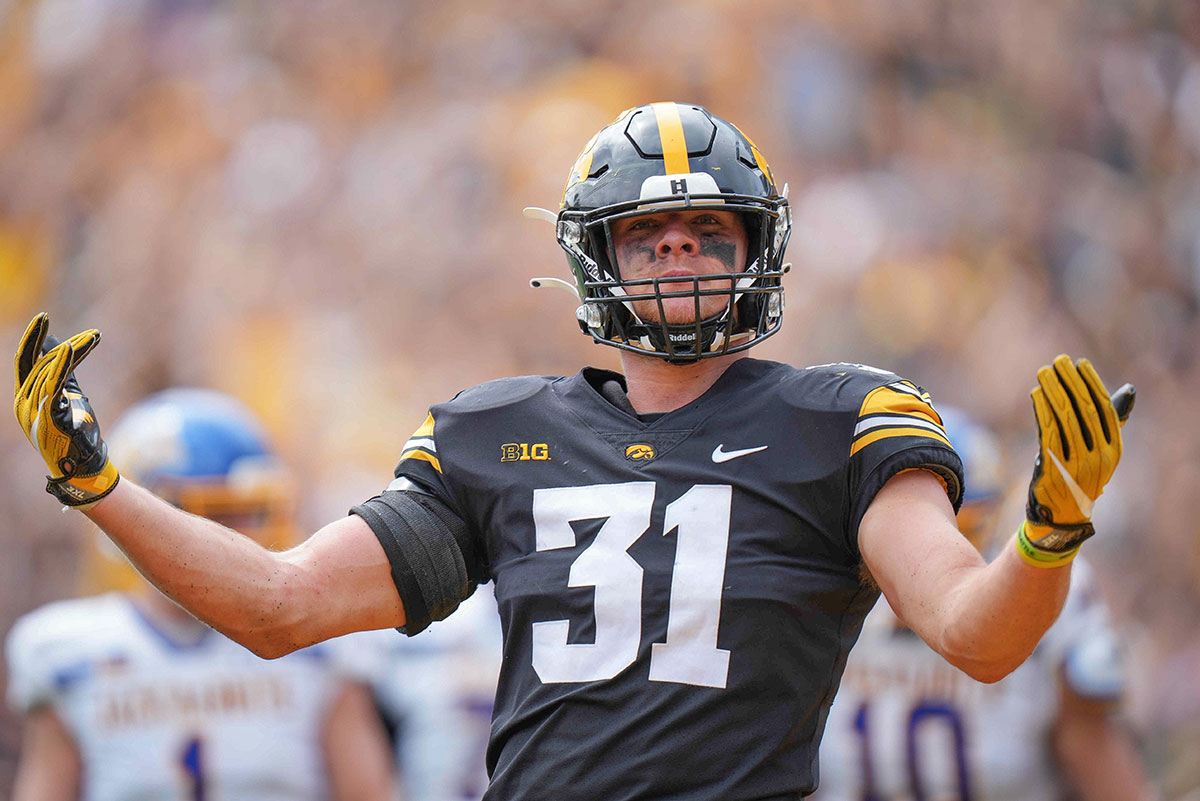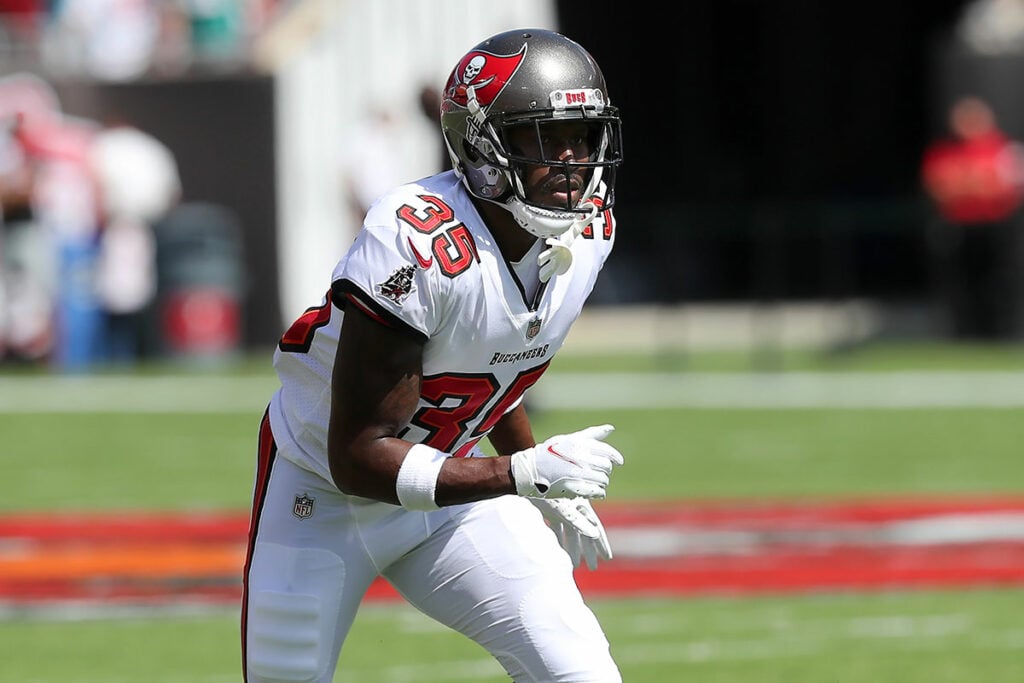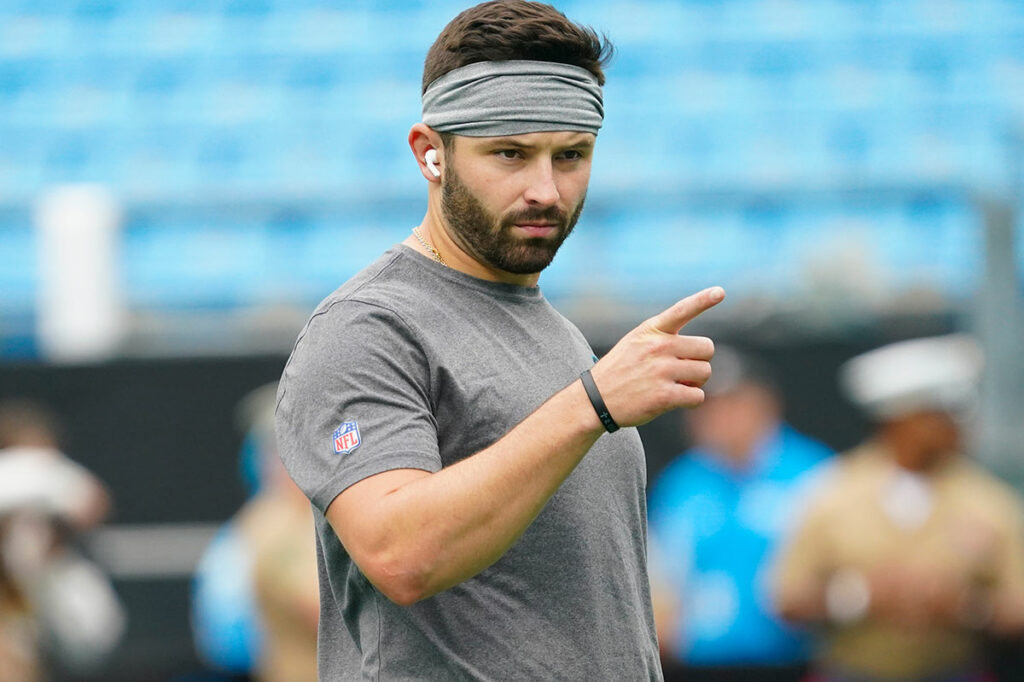Now that the first wave of free agency is behind them, the Bucs and the rest of the NFL world are beginning to set their sights on fully on the 2023 NFL Draft. Teams, draft analysts and fans alike are busy setting up their draft boards to improve NFL talent levels by organization. With the Bucs picking in the middle of the early rounds and having a bevy of picks late it makes it more difficult to really home in on the players the team may be targeting.
With that said, here are five players that may be available when the Bucs pick in the first couple of rounds that they should draft, but likely will not.
And the reasoning for why they won’t.
Georigia OLB Nolan Smith
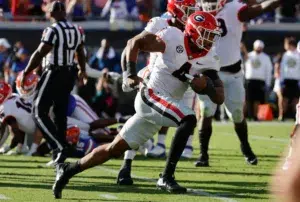
Georgia OLB Nolan Smith – Photo by: USA Today
Smith is an athletic, violent, and emotional leader on the field. His physical tools are drool-inducing. He possesses speed, explosiveness and agility in droves. For a more in-depth look at his abilities, you can read my draft profile on him here. Smith could immediately raise the ceiling of a Bucs outside linebacker room that features a whole lot more questions than the team envisioned when they selected Joe Tryon-Shoyinka in the first round in 2021.
Shaq Barrett may very well be cut this time next season, and while I personally think Tryon-Shoyinka is due for a big jump in 2023, that is far from a lock. Smith represents a big ball of clay that offers a sky-high ceiling and the demeanor to be an alpha at the position.
However, there are a host of reasons why the Bucs may not select him at number 19 overall. The first and most glaring is he just might not be there when they select. Smith’s Combine performance was one for the ages and he is getting legitimate hype as a possible Top 10-15 pick despite his lack of production at Georgia.
And that lack of production could factor into the Bucs’ decision to not select him if he is available when Tampa Bay picks in the first round. With only 12.5 sacks and 621 pass rush snaps in his career, Smith does not provide the most robust statistical resume for teams to consider.
Lastly, Smith comes with question marks about whether his size can hold up at the NFL level. At 6-foot-2 and 238 pounds, Smith’s height ranks in the 15th percentile and his weight ranks in the 2nd percentile of all edge rushers in the MockDraftable.com database. Furthermore, his arm length, which can be a huge asset for edge rushers is in just the 17th percentile. The only edge rusher who has had sustained success with a similar physical profile is Hasaan Reddick, and the Bucs may not feel like betting the 19th overall pick on a player who has a successful player comparison of one player.
Northwestern DT Adetomiwa Adebawore
If Smith’s Combine performance was one for the ages, Adebawore’s was an all-timer.
Adetomiwa Adebawore #RAS so far.
*Splits projected. pic.twitter.com/SDE0gEdp88
— Kent Lee Platte (@MathBomb) March 2, 2023
Kent Lee Platte evaluated Adebawore on his Relative Athletic Score system as a defensive end where he played at Northwestern. However, at the NFL level he projects more as a gap penetrating three-technique defensive tackle. This would change his RAS score card around quite a bit as his weight score would come down, but all of his athletic testing scores would improve.
The most apt comparison for Adebawore’s athletic testing is a very scary one. Future Hall-of-Famer Aaron Donald. The similarities are striking.
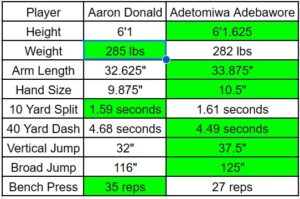
This is where the comparisons for the two should stop though. Donald’s bench press belied a strength not seen from any other player of his size the league has ever seen. It is that strength, combined with his compact size that has allowed him to become such a dominating force at the NFL level. And while Adebawore’s 27 reps does clear the mean for defensive linemen (25.381 per MockDraftable.com), it hardly comes close to the number Donald posted. Then there is the college resume. Donald posted almost as many sacks in his sophomore and senior years (11 each) as Adebawore logged for his entire four year career (12.5).
But with a glaring need at interior defensive line (currently only Vita Vea and Logan Hall are locks to be on the opening day roster), and a dearth of pass rushing talent in the draft, the Bucs should be considering whether they can harness Adebawore’s considerable athleticism as a part of a revamped pass rush in 2023.
Adeboware’s tape shows some skills that can be a sound foundation to build off of. He has a quick burst off the line. This allows him to be a gap-penetrator who can get after the quarterback quickly.
Adetomiwa Adebawore’s get off pic.twitter.com/9qf9VEnblC
— Nate Tice (@Nate_Tice) March 9, 2023
Due to his short frame Adeboware plays with a naturally low pad level and advantageous leverage. This gives him the ability to explode through offensive linemen’s mid-section in an upward fashion causing them to lose balance and anchor. He finishes his pro’s list with impressive hand-fighting ability, showcasing hand swipes that prevent opponents from latching on to him.
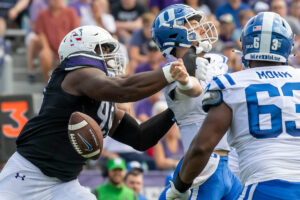
Northwestern DT Adetomiwa Adebawore – USA Today
With all of this considered, the potential pitfalls of selecting the Northwestern man are glaring. First off would be where he is selected. Much like Smith, Adebawore’s Combine (and his Senior Bowl performance prior to that) has him shooting up draft boards. Where he once was considered a mid-to-late Day 2 pick, he is now getting talked about as a late first-round, early second-round possibility.
This puts the Bucs in no-man’s and as the draft order is currently set. There is a strong possibility that he won’t be available when Tampa Bay selects at pick 50 in the second round but will be considered a substantial reach if they opt to grab him at pick 19.
Add in the fact that Adeboware has limited production and a small physical profile and there are real red flags for the Bucs and what they look for in an interior lineman. At under 6-foot-2, and with a very small waist it is reasonable to question whether Adeboware can add mass to his 282-pound frame. And if he does the follow up question becomes whether it will have a significantly adverse impact on his speed, lateral agility and explosiveness.
Adeboware just doesn’t fit the physical profile of a Todd Bowles defensive tackle (think 6-foot-5, 300-plus pounds).
Pittsburgh DT Calijah Kancey
Speaking of undersized defensive tackles from Pittsburgh, Kancey has also received some comparisons to Donald. But where Adeboware’s strength is within the same realm as Donald’s, Kancey’s isn’t even close to the same stratosphere. And if you thought Smith’s athletic profile featured low percentiles in height and weight, Kancey has accomplished the rare feat of a single slice on the MockDraftable.com visual chart.
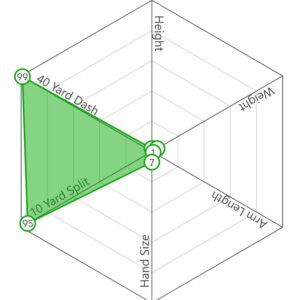
And yet Kancey is regularly mocked in the first round and could certainly fill a glaring need for the Bucs at 19. The reason is because he shows several reps each game where his explosiveness and pass-rush arsenal flash in the form of dominant reps that almost no other interior defender in the draft can offer. In a league where run-stopping tackles are a dime-a-dozen, Kancey has a skill set that is as uncommon as a leprechaun riding a unicorn while trying to escape from a bear hopped up on cocaine.
Still, he does not fit what the Bucs look for in an interior defender. While the team overlooked Logan Hall’s reduced weight last year when they selected him with the first pick of the second round, they were confident that he could add significant weight to his 6-foot-6 frame. And where there are questions about Adeboware’s ability to bulk up, there are no questions about Kancey, who has 30-inch arms. Adeboware has 33-inch arms. And at 6-foot, 281 pounds, Kancey is maxed out in that department and there is no hope for him to add the type of muscle to even sniff 295 pounds.
Iowa ILB Jack Campbell

Iowa LB Jack Campbell – Photo by: USA Today
Campbell has been one of the most fun watches of this draft cycle for me so far. Coming from a program that prides itself on showcasing players with everyman mentalities, Campbell is a guy whose tape shows he just loves to play football. At 6-foot-5-inches and 249 pounds, Campbell represents a physical profile that is a throwback to days of yore.
While the linebacker position has trended shorter, lighter and faster, Campbell offers a bigger body in the middle of the field that will undoubtedly cause opposing quarterbacks pause when trying to throw into tight windows over the middle. His tape will excite Bucs coaches because it features him being assignment sound in all aspects of his position.
Campbell communicates well with his teammates translating what he sees into actionable movements to put himself and others in the best position to defend the opposing offense. Campbell is gap sound in run defense and is not afraid to use his considerable size to lay the boom on running backs. And in coverage he effectively drops into zones and shows a willingness to cover players over ground, which is still the hardest skill to find in young linebackers.
The one question about Campbell’s profile coming into draft season was whether his athleticism had a lower ceiling than most top-tier linebacker prospects. Well, he put those questions to bed with his Combine performance. His 40-yard dash time of 4.65 seconds was very respectable and his explosive measurables were extremely strong. These numbers hold him back from entering first-round conversations that are reserved only for physical freaks like Devin White, but Campbell should be an option for the Bucs at pick 50.
With all of these things going for him why wouldn’t the Bucs consider the Iowa linebacker in the second round? From a longer-term perspective, it makes a boatload of sense for Tampa Bay to target the position with a guy who profiles as the most plug-and-play option at his position in this year’s draft. K.J. Britt is currently the only inside linebacker signed beyond 2023.
But if the Bucs do select Campbell, they would be spending a premium pick on a player who would not start year one now that Lavonte David has re-signed with the team to once again line up beside White. Given the current starting needs of the team at offensive tackle, safety, nickel corner, offensive guard, tight end and defensive end it would be a hard sell to prioritize a backup roster spot so highly. Still, by adding Campbell the team could open up the defense to get even more creative with White’s pass rush opportunities.
Utah TE Dalton Kincaid

Utah TE Dalton Kincaid – Photo By: USA Today
Coming off of a 70-catch, 890-yard season, Kincaid is a regular stalwart in the middle of first-round mock drafts. Conveniently enough, that is exactly where the Bucs pick. And with a significant production drop-off at the position last year and a new offense that could use a playmaker in that role it makes a ton of sense that Kincaid could be a valuable selection for new offensive coordinator Dave Canales.
Kincaid is a natural playmaker, consistently winning at the catchpoint and adding impressive yards after catch. He has logged about 40% of his snaps in-line with another 50% of them coming from the slot. This means he can be used in a versatile manner that would bode well for the Bucs’ new offensive scheme.
There is no athletic testing for Kincaid as he suffered a back injury shortly before the NFL Scouting Combine. But his tape does not scream athletic wonder, such as previous Bucs’ first-round tight end O.J. Howard. However, Kincaid shows a more advanced feel for understanding coverages and bending his routes to create separation. Kincaid may be the best natural pass catcher among a strong tight end class with only TWO (!!!) drops on 165 career targets at Utah.
Kincaid is not a perfect prospect. His blocking abilities can be described more as willing than effective, especially at 6-foot-3, 246 pounds. He gives good effort but lacks proper hand placement and impact to be a plus. If the Bucs were to select Kincaid, it would look more like a luxury pick than one that helps them round out their 2023 roster effectively. And while he may present a high-floor, good-ceiling option, the Bucs may not have him as the highest rated tight end available at that spot.
Georgia’s Darnell Washington has been making noise moving up draft boards. His blocking abilities are far superior to Kincaid’s as his size dwarfs that of the Utah prospect. At 6’7 and 264 pounds, Washington packs a punch while still showing functional athleticism. His 4.64 second 40-yard dash, 122″ broad jump and 4.08 second short shuttle are all evidence that despite limited college production Washington’s ceiling as a receiver could match or exceed that of Kincaid’s.
Ultimately the Bucs face a different problem than in recent years. Where their starting lineup has largely been defined prior to the draft and they were able to let the draft board fall to them, this year they have several glaring needs that may prevent them from selecting talented players at specific positions while also ignoring high-ceiling players with big question marks in favor of players that offer a greater positional need and higher-floor. The results in three years should be fascinating to revisit.
Josh Queipo joined the Pewter Report team in 2022, specializing in salary cap analysis and film study. In addition to his official role with the website and podcast, he has an unofficial role as the Pewter Report team’s beaming light of positivity and jokes. A staunch proponent of the forward pass, he is a father to two amazing children and loves sushi, brisket, steak and bacon, though the order changes depending on the day. He graduated from the University of South Florida in 2008 with a degree in finance.

